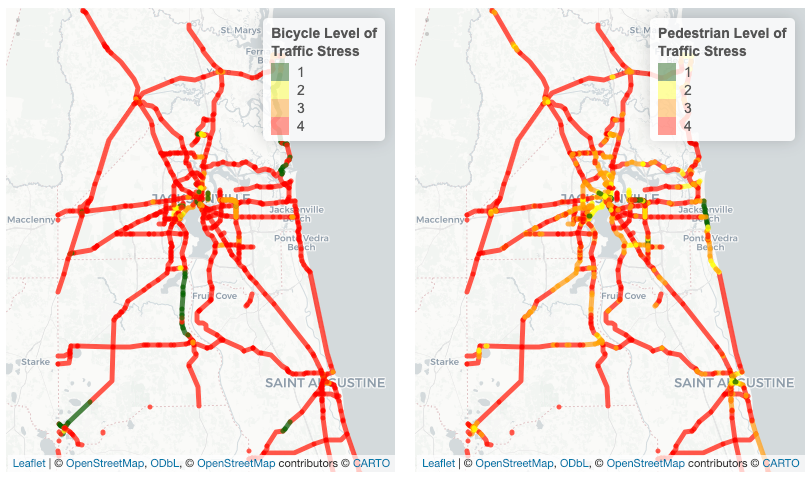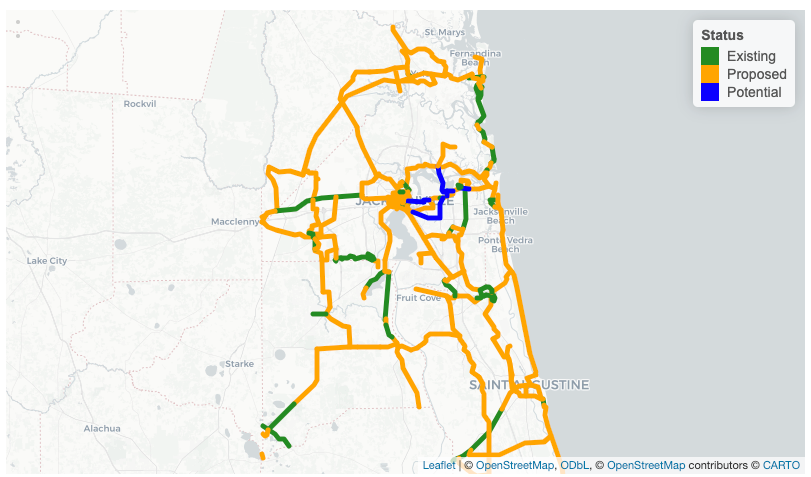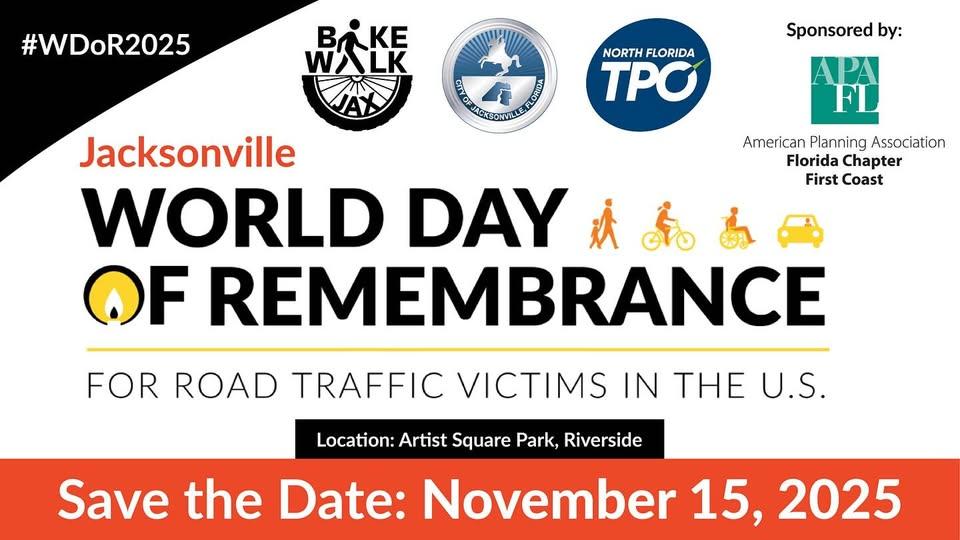Bicycle/Pedestrian Planning
Multimodal planning seeks to provide pedestrians and bicyclists with a safe, accessible and connected transportation network.
Normandy Blvd: First and Last Mile Pedestrian Safety Study
The study analyzed existing conditions within a half-mile radius of bus stop on Normandy Boulevard (JTA Route 14) by identifying and prioritizing infrastructure needs—such as sidewalks, bike lanes, and crosswalks—to enhance safety, increase transit ridership and support safer first- and last-mile connections. These findings, recommendations and cost estimates were developed to guide future improvements and support coordinated planning among local agencies. View the summary brochure.
Moncrief Road Corridor Study: 13th Street to US 1/New Kings Road
The study looked at the Moncrief Road corridor by identifying existing access management issues and identifying feasible strategies to improve the corridor safety and performance for all users.
Core to Coast Trail: Alignment Feasibility Study (Southern Section)
The study examined the initial feasibility of a continuous trail from downtown Jacksonville to Jacksonville’s beach communities. The report details multiple desired alignments, community hubs along the route, and estimated costs of the trail. View the summary brochure.
Pine Street: Pedestrian and Bicycle Study
This corridor safety study evaluated the pedestrian and bicycle safety along Pine Street in Nassau County. The study includes traditional strategies such as building sidewalks and installing pedestrian signals as well as low-cost improvements to connect to local schools and amenities.
Bicycle and Pedestrian Master Plan Update
This plan is a comprehensive review and update for the Bicycle and Pedestrian Master Plan published in October 2013. The update will build upon the plan by examining the North Florida TPO’s bicycle and pedestrian planning efforts including policies, projects, demographics, high crash areas, and community input to develop a set of recommendations for future bicycle and pedestrian planning for North Florida.
Duval Schools Walkability Study
The purpose of the study was to develop a methodology for conducting a context sensitive school walkability analysis that can be replicated for schools throughout the region. The results of the walkability analysis will identify the barriers to pedestrian access to schools with a focus on infrastructure and safety improvements.
Learn more about related planning studies and initiatives.
Signal4 Analysis Is an interactive, web-based system designed to support the crash mapping and analysis for Florida Professionals.
FDOT Non-motorized Traffic Monitoring Program
The site outlines the program and showcases the non-motorized user dashboard offering a statewide map with travel data and monitoring stations. Also, individuals can request new non-motorized user count stations on the site.
Florida’s Shared-Use Non-motorized (SUN) Trails Network GIS map displays the state’s network of priority paved trails and their associated funding status.
Florida’s Pedestrian and Bicycling resource center offers FREE safety resource materials. Community partners can order informational materials, helmets and other swag items.
District 2 Traffic Safety Team
The Traffic Safety Team is made up of members, agencies, and community partners in the district. The group serves as an opportunity to educate, exchange, and share data, information, materials, campaigns, and ideas among traffic safety professionals in Northeast Florida.
FDOT Roadway Design Office: Bicycle and Pedestrian Facilities
A comprehensive resource related to state-wide bicycle and pedestrian planning and design. The site includes FDOT specific resources, district contacts, design guides, traffic laws, and more.
The Florida Local Technical Assistance Program (LTAP) center provides training and technical assistance to local agencies that is supported by FHWA. There are a number of recorded workshops and series on bicycle and pedestrian programs and topics.
The district 2 Traffic Safety Team has gathered e-bike safety recommendations, tips, and guidelines. Please use and share these materials, videos, and information to help improve safety and encourage safe e-bike and e-device usage.
Local and County Governments can apply for Florida’s Shared-Use Non-motorized (SUN) Trails funding to design and construct paved trails within or adjacent to the SUN Trails network.
Transportation Alternatives (TA)
TA funds a variety of smaller-scale projects to aid accessible non-motorized travel including on- and off-road bicycle and pedestrian facilities, recreational trails, safe routes for non-drivers, safe routes to schools, and ADA requirements.
FHWA Pedestrian and Bicycle Funding Opportunities Table
The table indicates likely eligibility for pedestrian and bicycle activities and projects under U.S. Department of Transportation surface transportation funding programs.
Target Zero is a statewide initiative to reduce the number of transportation-related serious injuries and deaths across Florida to ZERO.
The Safe Routes to School (SRTS) is a nationally recognized program that supports safe travel to and from school, which aims to encourage more students to walk and bike to school. The program aims to educate students, parents, involve law enforcement, city officials and address necessary infrastructure needs for safety.
This program aims to address driver yield rates at crossing by through education, engineering, enforcement and evaluation. The program is expanding into North Florida to help reduce serious bicycle and pedestrian injuries and fatalities.
The Bicycle and Pedestrian Level of Stress Maps from the North Florida TPO Annual Mobility Report show the degree of traffic stress (1=lowest to 4=highest) based on comfort factors such as pavement condition, heavy vehicle presence and facilities at intersections.

The Regional Multi-use Trail Master Plan shows existing, proposed and potential trails and connections.

Events

Staff Contact
Thalia Fusté
Transportation Planner
TFuste@northfloridatpo.com
Office (904) 306-7503
Cell (904) 829-7876
